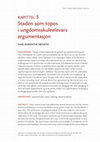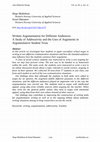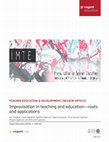Papers by Sissel Høisæter
Environmental Education Research, May 19, 2023

Demokratisk danning i skolen, 2019
Mange samfunnsspørsmål har globale og nasjonale dimensjonar, men motivasjonen for å delta i samfu... more Mange samfunnsspørsmål har globale og nasjonale dimensjonar, men motivasjonen for å delta i samfunnsdebattar kan bli større om ein kan forankra debatten i lokale tilhøve. Dette kapittelet er ein topologisk analyse av korleis elevar i ungdomsskulen nyttar kunnskapar om lokalmiljøet sitt i ein debatt om oljeutvinning. Analysegrepet er å sjå på bruken av ulike stads-topoi (innhaldselement knytt til stader) i argumentasjonen. Analysen av debatten dreier seg både om korleis elevane nyttar spesielle topoi (sakkunnskap om naermiljøet) og generelle topoi (måtar å ordna argumentasjonen knytt til stader) i debatten. Dei spesielle topoia som blir undersøkte, er kunnskap knytt til arbeidsplassar, heimstaden som turiststad, som handelstad, og argument knytte til bruken av havet. Dei generelle ordens-topoia som blir undersøkte, er bruken av analogi, årsak-verknad, dikotomiar og polarisering. Eit sentralt funn er at elevane i stor grad forstår dei sosioøkonomiske forholda knytte til spørsmålet om oljeutvinning i naerregionen ved å sjå på kva konsekvensar utbygging eller ikkje utbygging vil få for det lokale kjøpesenteret, og at dei på den måten i stor grad forankrar forståinga si av utbyggingsspørsmålet i det naere og kjente.

Acta Didactica Norge, 2018
In this article we investigate how students in upper secondary school argue in writing in two dif... more In this article we investigate how students in upper secondary school argue in writing in two different communicative situations and how the intended audience may influence how the students construct their arguments. A class of social science students was instructed to write a text arguing for how we may best prevent crime. The text was to be handed in as homework within the week. The same week, the students were instructed to write a text in an online discussion forum about a topic relevant to social science, arguing in favor of their opinion. We collected 34 texts from 17 students in one class, one from each student in each of the two communicative situations. Our findings show that although the students in both tasks were asked to argue for an opinion, the argument fulfills different purposes in the different situations, and the different audiences played an important role in the way the argumentation was carried out. The students tend to argue with intellectual appeal, using dat...

Cogent Education, 2016
The main aim of this review article is to understand and discuss the concept of improvisation as ... more The main aim of this review article is to understand and discuss the concept of improvisation as a professional skill for teacher educators. The literature review suggests that five academic traditions are especially relevant to examine: Rhetoric, music, theatre/drama, organizational theory and education. The dialogic, open-scripted, interactive and responsive aspects of improvisation are common features for all the traditions we have examined and could provide a common basis for improvisation as a key curricular concept in teaching, and hence teacher education. Every day teachers are challenged to act in accordance with the situational needs and requirements arising in different pedagogical situations. We have identified four different aspects of improvisation, which appear to be of crucial importance in any discussion about improvisation as a key concept in education: (1) Communication and dialogues: Communication in improvisation can be described along a continuum of two positions: From the internal process of communication itself to the external intended result of it. The purpose can also vary from emphasizing the effect on the audience to emphasizing the process of exploration. (2) Structure and design: All traditions claim that to be a good professional improviser, you have to be aware of and be skilled in planning and structural thinking. (3) Repertoire: Learnable
Paradeigma og exemplum……………………………………………………………..32 2.2 Definisjonar av eksempelet……………………………………………... more Paradeigma og exemplum……………………………………………………………..32 2.2 Definisjonar av eksempelet……………………………………………………………41 2.3 Moment til ein eksempeldefinisjon, ei drøfting ………………………………………57 2.4 Eksempelets dialektiske nivå, ein modell……………………………………………...85 2.5 Eksempelets retoriske nivå, ein typologi………………………………………………98 3 Kunnskapens orden, ein ekskurs ……………………………………………………..115 4 Didaktikk og topologi…………………………………………………………………141 5 Analyse………………………………………………………………………………..155 5.1 Moment, prinsipp og grep i analysen av eksempel…………………………………..











Uploads
Papers by Sissel Høisæter